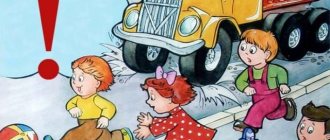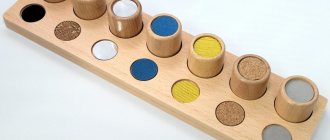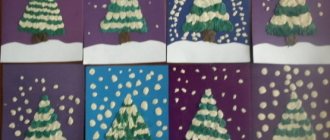Mnemonics. Reference pictures, mnemonic tables
The publications in this section contain many useful examples of using mnemonic tables and other visual teaching aids in everyday work with children.
Here everything is about how to use the capabilities of mnemonics in learning.
Contained in sections:
Includes sections:
Mnemonics as a means of developing speech, memory and thinking “Teach a child some unknown five words - he will suffer for a long time and in vain, but associate twenty such words with pictures , and he will learn them on the fly.” K.D. Ushinsky Mnemonics is the art of memorization, the history of which goes back more than 2000 years. Mnemonics is.
The use of mnemonics in working with preschool children Report “The use of mnemonics in working with preschool children” Educator: senior group No. 9 Zikhova M.R. g.p. Nartkala 2022 Report for educators on the topic: “Using mnemonics in working with preschool children” “Teach your child something.
Publication “Consultation “Mnemonics - an effective method for developing speech.” » Article » Mnemonics is an effective method for developing speech in preschoolers» What is mnemonics? “Teach a child some five words unknown to him, he will suffer for a long time and in vain, but associate twenty such words with pictures, and he will learn them on the fly.” Ushinsky K.D.
Final open lesson “Drafting a description of the appearance of a wild animal using a mnemonic table”
Topic: Drawing up a description of the appearance of a wild animal using a mnemonic table. Goal: • Continue to teach how to compose a descriptive story about a wild animal using a mnemonic table; develop the ability to carefully examine a picture and reason about its content. Objectives: Developmental: •.
GCD for speech development using mnemonics in the junior group “Compiling a descriptive story about a toy” “Compiling a descriptive story about a toy” Goal: Development of coherent speech in children by composing a descriptive story using a mnemonic track. Tasks: coherent speech: teach children to answer the teacher’s questions, describe the subject; compose using.
Master class for teachers “Mnemonics” Master class for teachers “Mnemonics as an actual technology in the implementation of the tasks of educational areas in preschool educational institutions” Senior teacher: Kucherova T.N. Purpose of the master class: To familiarize teachers with the educational technology of mnemonics, which ensures effective memorization.
The article “Summary of GCD for speech development” “Composing a story about birds according to. »
Abstract of the GCD for speech development “Composing a story about birds using a mnemonic table” Koneva Anastasia Irikovna Stages of activity - Motivational and incentive The teacher suggests solving a riddle: A worm dreams at night of a Miracle Yudo on a branch: A long beak and two wings... If it flies, it’s bad.
Summary of educational activities for speech development using mnemonics “Memorizing the poem “What is Victory Day?” Summary of direct educational activities on speech development in the preparatory group On the topic: “Memorizing the poem by A. Usachev “What is Victory Day?” with the help of mnemonics, mnemonic tables.” Goal: to develop children’s interest and need for memorization.
Source
Features of use
When practicing in the form of a game with mnemonic tables, children are asked to:
- review speech therapy cards;
- remember what is described;
- talk about what you saw, focusing on the pictures.
When children use mnemonics and perform assigned tasks, they actively carry out the following processes:
- viewing diagrams and understanding what you see;
- transformation of visual data into figurative data, identification of what is seen with a concept;
- compiling a story based on drawings;
- memorizing fairy tales, stories, etc.
Older preschoolers can themselves take part in compiling mnemonic tables, focusing on the words of the teacher, who broke the story (fairy tale, riddle) into situations, explaining what needs to be drawn. The simplest and most interesting option is to depict a mnemonic table on the theme of the seasons (summer, winter, etc.) or based on fairy tales (best of all, your favorite ones).
The development of children's coherent speech in older preschool age is also possible and necessary at home (at any time convenient for parents and the baby). This can help:
- joint reading of books with fairy tales, equipped with bright illustrations, reciting the main points and highlighting key characters and events;
- regular use of fiction as an effective means for increasing the level of development of coherent speech;
- a large book with tasks and exercises aimed at the active development of a child’s coherent speech (can be purchased in the children’s educational literature department of any bookstore);
- Doman cards;
- methodological recommendations for the development of coherent speech; other methods at the discretion of parents and the advice of teachers and speech therapists.
Table of contents
Luponos Zoya Nikolaevna, teacher – speech therapist, MDOU kindergarten No. 1 “Alyonushka”
There is no area in human activity where speech is not used. It is needed everywhere. And especially at the learning stage. The success of his education depends on the quality of a child’s speech, so the main task of parents, educators and speech therapists is speech development. Pure, correct speech is one of the most important conditions for normal human mental development. With the help of speech and communication, the child easily and imperceptibly enters the world around him, learns a lot of new and interesting things, and can express his thoughts, desires, and demands. Unfortunately, these days children are becoming more and more speech impaired, which severely limit their communication with people around them. Inadequate speech development also affects the formation of non-speech mental processes: insufficient stability of attention is observed, verbal memory is reduced, and memorization productivity suffers. Corrective action should be based on the maximum use of the child’s capabilities. When teaching coherent speech, I use mnemonic techniques in my work. Mnemonics, or mnemo technique a system of various techniques that facilitate memorization and increase memory capacity by forming additional associations. Since preschoolers’ memory is involuntary: they remember facts, objects, and phenomena better, my teaching material is mnemonic tables—diagrams that contain certain information. Mastering the techniques of working with mnemonic tables significantly reduces training time and at the same time solves problems aimed at:
- development of basic mental processes - memory, attention, imaginative thinking;
- development of fine motor skills of the hands with partial or complete graphic reproduction of the text.
Using supporting drawings to teach memorizing poems captivates children and turns the activity into a game. The visual image that the child retains after listening, accompanied by viewing the drawings, allows him to remember the text much faster. To learn each poem, I develop and compile my own mnemonic table. First, I select supporting elements and fragments of the picture for the selected poem (preferably for each line), scan and, using a computer, process individual fragments to create a picture. And so, step by step, a mnemonic table is created. During the period of my work as a teacher-speech therapist, I created a series of mnemonic tables on poems on various topics: “Bread”, “Spring has come”, “Snow Woman”, “In the Forest”, “Defenders”, “My Mother” and many others. The next stage of working with the mnemonic table is an emotional, expressive reproduction of the text of the poem. Then I conduct vocabulary work on the work, a conversation on the meaning of what was read, and provide the opportunity for children to reproduce the text based on the drawings. The table-drawing hangs in a prominent place in the speech therapist’s office. Summary of a lesson on speech development in the preparatory group.
Topic: Life of wild animals in winter.
Correctional and educational goals: Consolidating ideas about wild animals, their appearance, lifestyle in winter, habits. Clarification, expansion and activation of the dictionary on the topic “Wild Animals” {animal, beast, bear, wolf, fox, squirrel, hedgehog, fur, skin, paw, den, hole; wild, predatory,). Teaching children to memorize a poem based on visual images (mnemonics). Improving the grammatical structure of speech (the use of nouns with the suffixes -onok-, -enok-, -am-, -yat. Corrective and developmental goals. Development of coherent speech, speech hearing, sense of rhyme, visual perception and attention, articulation, fine and gross motor skills , coordination of speech with movement. General speech skills, sound pronunciation, clarity of diction, intonation expressiveness. Correctional and educational goals. Formation of skills of cooperation, mutual understanding, goodwill, independence, initiative, responsibility. Fostering a love of reading fiction, poetry; respect for nature . Equipment. Computer, dry pool (beans), animal figures, plumes for breathing exercises, mnemonic table for the poem “Bear in the Forest”, pyramid of games, P. I. Tchaikovsky’s work “Seasons. Winter” (recorded). Preliminary work Learning the finger massage “Bear.” Reading M. Rapov’s fairy tale “The Hedgehog and the Squirrel”, V. Bianchi’s stories “Preparing for Winter”, “Adapted”.
LESSON PLAN
- Organizing time. Announcing the topic of the lesson. Creating an emotionally positive background.
- Development of fine motor skills, tactile sensitivity. Working in a dry pool (beans or peas) Search for planar figures.
- Writing a descriptive story. Description according to the diagram of the appearance and characteristics of wild animals (found in a dry pool).
Ask 3-4 children.
- Expressive reading of L. Kvitko’s poem “Bear in the Forest”
- Vocabulary work. Work on phrases and words: “Cold on the nose”, “The forest is almost completely stripped”, “The wind blows and sows”, “The evening has fallen”.
- Conversation on content.
- Repeated reading of the poem with the intention of memorizing.
- Independent reading of a poem by children (1-2 children).
- Physical exercise. Breathing exercises.
- Reading the poem to the other children. (Analysis and evaluation of the narration of the poem - after each reading by the child).
- The game is a labyrinth: “Help the bear get to the den”, “What animals are hiding?”
- Summary of the lesson.
Progress of the lesson
1. Organizational moment. The speech therapist organizes a greeting with the children, invites them to the office beans on the floor. It contains flat images of wild animals. Speech therapist. Go to the dry pool and put your hands in it and find one object at a time. Children complete the task. Speech therapist . What did you find? Children. We found figures of a squirrel, a bear, a fox, and a wolf. Speech therapist. Who are they? Children. These are wild animals. Speech therapist. Why are they called that? Children. They live in the forest, build their own housing and get food. Speech therapist. In today's lesson we will talk about wild animals, their life in winter, and I will also tell you a story that happened to one of the animals. 2. Main part Speech therapist. Guys, now you will write a story - descriptions of those animals whose figurines were taken out of the pool. First, you will say the name of your animal and then follow the scheme for describing the animal (Appendix 3). 1st child . A squirrel lives in a hollow tree. She has a long fluffy tail and tufted ears. By winter, the squirrel stores nuts, cones, and mushrooms. The squirrel does not scream, but clicks “tsk-tsk-tsk.” Her cub is a baby squirrel. 2nd child : The wolf is a predatory animal, lives in a den that it suits. Outwardly he looks like a dog, his fur is gray; he runs fast. Wolves hunt deer and large animals only in packs, and individually hunt small animals. A wolf cub is a wolf cub, baby wolf cubs look like puppies. 3rd child : The fox is a predatory animal, taller than a cat, but smaller than a dog, lives in a hole; There are claws on the paws, a long fluffy tail - the beauty and pride of the fox. Its body is covered with fluffy, brown or red fur. She has a very good instinct: she finds small animals by their tracks - a mouse, a hedgehog, a hare. 4th child: This is a bear, a wild animal. He lives in the forest and sleeps in a den in winter. It's big and brown. He has thick fur, a huge head, strong paws, and a small tail. His cubs are cubs. The bear can growl in a rough voice. The bear loves honey and raspberries, eats roots, and destroys anthills. The speech therapist praises each child for writing a story.
3. Reading the poem by L. Kvitko: “Bear in the Forest” Speech therapist: Guys, now, I’ll tell you a story that happened to a bear at the very beginning of winter, when he was preparing for hibernation. This is a poem , and it was written by the poet L. Kvitko. (Children sit on chairs, and the speech therapist demonstrates a presentation on L. Kvitko’s poem “Bear in the Forest.” The slide show is accompanied by an expressive, emotional reading of the poem by heart).
L. Kvitko “Bear in the Forest”
A bear walks through the forest, A bear wanders through the forest - Cold, cold on the nose - It’s very cold in the forest! The forest is almost completely stripped: There is no nest, no bird. Only the wind moans and groans, driving leaves along the paths, here and there. The bear stood on tiptoe, the bear stretched out its paws: “Wind, wind, don’t whistle!” A cloud of snow is coming! Powder all the trees, Powder all the bushes! The wind blows, blows, blows. It sows and sows with warm snow, Pooh and fluff - White all around. It immediately became quiet. The snow lies like a blanket. Evening fell to the ground... And where did the bear go? The worries are over - Sleeping in his den
4. Conversation based on content. Vocabulary work
Speech therapist. Children. Did you like the story about the bear?
Children. Yes.
Speech therapist. Tell me, guys, how do you understand “Cold on the nose”?
Children. – My mother says: the report is coming.
Speech therapist. That's right guys, this means it will soon be cold. What does it mean, “The forest is almost completely “stripped”?
Children. – Leaves are the clothes of the trees, and the wind blows the leaves and, as it were, “undresses” the trees.
Speech therapist. Right. Children, tell me, who was the bear talking to?
Children. - With the wind.
Speech therapist. What did the bear ask the wind?
Children. “No matter what he whistled, he covered everything with snow.”
Speech therapist. How did he ask?
Children. The bear stood on tiptoe, the bear stretched out its paws...
Speech therapist. Let's ask the bear for the wind: ( Choral repetition of the bear's request)
Children. - Wind, wind, don’t whistle! A cloud of snow is coming! Powder all the trees, Powder all the bushes!
Speech therapist. Guys, do you think the wind fulfilled the bear’s request?
Children. Having completed this, he began to slowly winnow and sow snow, and poured snow on it as a “blanket.”
Speech therapist. Well done, the wind fulfilled the bear’s request. Tell me, children, what does it mean that the snow lies like a “blanket”?
Children. It’s warm under the snow - and the ants and mice and roots don’t freeze.
Speech therapist: Well done! Sasha, you understand correctly. And who can say how evening fell to the ground?
Children . In winter, the days are short, the sun sets and it gets dark quickly. So they say that evening has fallen - it quickly got dark.
Speech therapist. Right! Guys, listen to this poem again.
5. Repeated telling of the poem with the intention of memorizing the poem. (Set up a mnemonic table) The speech therapist reads poems emotionally, expressively correlating each part with the picture of the mnemonic table, showing the sequence with a pointer.
6. Physical exercise. Children imitate:
- bear gait,
- standing while asking:
- the bear stood on tiptoe, - the bear stretched out its paws.
- Sleeps in a den.
7. Breathing exercises. To the music of P.I. Tchaikovsky "Seasons. Winter" children perform gymnastics exercises:
- Wind: - whistles,
- Storm
- It blows
- groans
8. Repeated telling of the poem with the intention of memorizing the poem. Speech therapist. Children, I will read the poem again. Try to remember the intonation, the pitch of the voice with which I pronounce the words of the poem in each picture. (The poem is read by a speech therapist based on the pictures of the mnemonic table).
9. Reading a poem by children. Children recite a poem based on mnemonic table pictures, a speech therapist helps children with different levels of speech development using techniques: prompting the first words of a line, difficult words, conjugate speech techniques, and more. 10. Analysis of children's reading of the poem. After each reading of a poem by children, an analysis of the story follows, involving children with a good memory.
11. Game. Guys, the bear left his supplies for you and me, but to get to them you need to complete tasks: first, find all the animals that are hidden in the picture (children are offered riddle pictures “What animals are hidden here?”) Appendix 4 . Second task: Game - labyrinth “Help the bear get to the den.” Appendix 3.
12.Result of the lesson. Speech therapist: Guys, what new did we learn in class? Children: - A story about a bear that happened to him at the beginning of winter. — we helped the bear get to the den and completed the correct drawing of the letters that we know. — found hidden animals in the picture and described them according to the diagram. — learned a new poem. Speech therapist: Well done guys, we managed to do and learn a lot today in our lesson. And most importantly, we learned L. Kvitko’s poem “The Bear in the Forest”; was it difficult to memorize it? Children: No. With tables we learn poetry quickly.
Annex 1
Appendix 2 Scheme for describing animals .
- What is it called? 2. Is this a wild or domestic animal? 3. Where does it live? What is the name of his home? 4. What size is it? 5. What color is it? 6. What is his body covered with? 7. What body parts does he have (their features)? 8. What are the baby animals called? 9. What sounds does the animal make? 10. What does it eat?
Appendix 3 Game - labyrinth
Appendix 4 Picture - a riddle What animals are hiding here?



